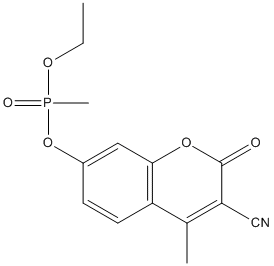EMP-MeCyC
VX analogue. BRENDA 40691, Fluorogenic organophosphate diesters that produce fluorescence emission upon hydrolysis. The first ester is ethyl (E), isopropyl (I), cyclohexyl (C) or pinacoyl (P) analogous to the structure of VX, Sarin, Cyclosarin, and Soman respectively. The fluorescent ester is 3-cyano-4-methyl-7-hydroxy coumarin (MeCyC) or 1,3-dichloro-7-hydroxy-9,9-dimethyl-9H-acridin-2-one (DDAO)
General
Type : Cyanide,Organophosphate,Flu-OP,Nerve Agent V-series,Surrogate OP,Coumarin
Chemical_Nomenclature : methylphosphonic acid 3-cyano-7-hydroxy-4-mehtyl-2oxo-2H-coumarin-7-yl ester ethyl ester
Canonical SMILES : CCO[P](=O)(C)OC1=CC2=C(C=C1)C(=C(C(=O)O2)C#N)C
InChI : InChI=1S\/C14H14NO5P\/c1-4-18-21(3,17)20-10-5-6-11-9(2)12(8-15)14(16)19-13(11)7-10\/h5-7H,4H2,1-3H3
InChIKey : LUQXHRFMIZMOBO-UHFFFAOYSA-N
Other name(s) :
MW : 307.24
Formula : C14H14NO5P
CAS_number :
PubChem :
UniChem : LUQXHRFMIZMOBO-UHFFFAOYSA-N
IUPHAR :
Wikipedia :

Target
References (2)
| Title : Asymmetric fluorogenic organophosphates for the development of active organophosphate hydrolases with reversed stereoselectivity - Amitai_2007_Toxicology_233_187 |
| Author(s) : Amitai G , Adani R , Yacov G , Yishay S , Teitlboim S , Tveria L , Limanovich O , Kushnir M , Meshulam H |
| Ref : Toxicology , 233 :187 , 2007 |
| Abstract : Amitai_2007_Toxicology_233_187 |
| ESTHER : Amitai_2007_Toxicology_233_187 |
| PubMedSearch : Amitai_2007_Toxicology_233_187 |
| PubMedID: 17129656 |
| Title : Enhanced stereoselective hydrolysis of toxic organophosphates by directly evolved variants of mammalian serum paraoxonase - Amitai_2006_FEBS.J_273_1906 |
| Author(s) : Amitai G , Gaidukov L , Adani R , Yishay S , Yacov G , Kushnir M , Teitlboim S , Lindenbaum M , Bel P , Khersonsky O , Tawfik DS , Meshulam H |
| Ref : Febs J , 273 :1906 , 2006 |
| Abstract : Amitai_2006_FEBS.J_273_1906 |
| ESTHER : Amitai_2006_FEBS.J_273_1906 |
| PubMedSearch : Amitai_2006_FEBS.J_273_1906 |
| PubMedID: 16640555 |